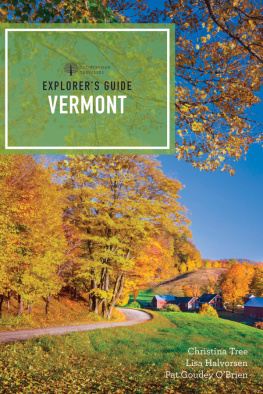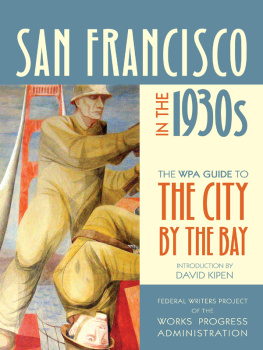THE first Community Church in America was built a century and a quarter ago in a small Vermont village. The fact has gone little-noted by commentators zealous to preserve the over-simplified concept of Vermont as the epitome of individualism. Yet it was no historical inadvertence, for surely the Green Mountain Boys themselves attest co-operation to be one of the valid and basic traditions of the State. A co-operative book, therefore, on Vermont by Vermonters, no more offends propriety than a co-operative creamery, or the house-raising of earlier days, or any other community enterprise. New Englanders have always had to work together. And if writers are to be induced to work together (that slightly staggering postulate upon which the American Guide series of publications is based), New England writers might be expected to bring it off with somewhat less than the normal anguish. It is not, then, so unusual that Vermont should be represented fairly early in the list of State guide-books created by the Federal Writers Project of the Works Progress Administration. Perhaps that skepticism, ostensibly joyless but actually one of the few secret delights of the Puritan soul, which one finds so common north of Boston, was a help. No Vermont farmer will admit until after the hay is in the barn that he really expects a catch in any given season. No Vermonter is old enough to remember a season when crops really did fail.
This is a new kind of book. It was written in a new way. Time will judge the quality of both innovations, but each at least adds a little to the immemorially tenuous excuse for a Preface. Under the circumstances something may usefully be said here as to what the volume aims at and how it was put together.
The newness of the book consists primarily of its tours. Twenty-five hundred miles of road, paralleling and crossing and curling around the countless ridges of the Green Mountains, have been described, in a way which, it is hoped, will not merely facilitate but also suggest and stimulate travel. The statistical staunchness of the indispensable old blue-book (with its junctions at helpful red barns, just 1.3 miles from its essential watering-troughs) has been retained to the fullest feasible extent. But further than this there has been an effort to interweave the background of a State the scenery, the history, the society and the culture of Vermont so that the visitor may become conscious of our landscape in a genuine, a three-dimensional fashion.
Yet even the most ardent advocate of decimal mileages will acknowledge the need for a wider orientation, if one is to make progress toward understanding a region. We have, therefore, opened the book with a series of brief introductory essays, calculated not to provide definitive studies of agriculture, ethnology, industry, architecture, or meteorology, but aimed rather at giving the reader a succinct yet adequate outline of the society and the corner of the earth which he will find more specifically commented upon as he pursues the tours.
To avoid interrupting the continuity of the tour descriptions, we have lifted out the portions dealing with the larger towns and given them an independent section in the volume. There is a selective bibliography for those who may wish to dig a little deeper beneath the surface; there are maps for the cartographically minded who enjoy the surface for its own sake.
None of this is individual procedure; it is laid out according to the standard plan for all State guide-books in the American Guide Series. Standard likewise have been the organization and carrying out of the work.
Nobody in his senses would attempt to explain how writers work. But some light can be thrown upon the way in which the material for this volume was assembled so that it could be worked upon. A score or more of research workers scattered throughout the State were engaged for over a year in gathering data and in forwarding it to Montpelier. A handful of editors in the central office sifted and checked and revised this accumulation. A still smaller group took the results in hand and in mind and went out on the road, covering every foot of the tours (in some cases driving over sections three or four times), and returned to piece together the mosaic of the tour descriptions. A great amount of independent research by the editors was, of course, also required before any final copy could be produced. And the contributions of voluntary assistants and consultants (of which, fortunately, almost every town furnished generous examples) had to be incorporated. But even then it sounds simpler than it was. It remains only to note the rle of that parvenu in literary nomenclature, and still slightly anomalous individual the State Director. A State Director functions as an absorbent of worries and an occasional suggester of similes. His job, being a baffling combination of midwifery and the assembly line, can scarcely be expected to attain the dignity of a profession. He is mentioned only because so many people will ask why he exists.
If a book cannot stand on its own feet, it is certainly not to be justified for its by-products. At the same time, no volume like the present can come into being without a variety of corollary results. And of the many such, I believe two definitely significant. One is the indication, which strengthens with each new publication of the American Guide Series, that writing can be nationally fostered, that literature will ultimately repay, as other arts have for centuries, what governments choose to expend upon it. The other result likewise is to be thought of as applying nationally. It lies in the impact which this work has inevitably made upon the minds of the writers themselves. If great writing must be rooted in the soil, if genuine creation must grow out of the artists intense identification with his background, is it too optimistic to expect that these forty-eight State books will help to prepare at least a few writers who, in the years to come, can write more deeply of America through knowing their parts of America deeply?
At the risk of redundance (since all this book is Vermont), one word more may be spared about the State itself, about its rle in the country today. No Vermonter would wish to deny that the State has, from the outset, carried particularism to the verge of intransigence; the motives only are in dispute. Vermont apologists have defended this attitude as the very essence of liberty. Outside observers have considered it as a consistent manifestation of unenlightened perversity.
Both assumptions are misleading. For Vermonts early attitude of defiance resulted from the radicalism of hard-pressed frontiersmen; in recent years ultra-conservatism has distinguished this region from other parts of the country where progressive tendencies have been, for a generation, on the increase. The decade from 1850 to 1860 was a pivotal one here. Then it was that the population curve for a hundred hill towns turned downward. If Yankee Doodle was literally the overture to the exciting era of Vermont history, Susannah was as clearly the recessional. The people, the wealth, the energy that had built the State were from then on either drained westward or gradually hardened into a more restricted pattern. Lacking large cities and the consequent opportunities for successful careers, Vermont has for three generations exported its most promising young people to urban centers outside its borders. The resultant population has an abnormally high proportion of elderly people.








